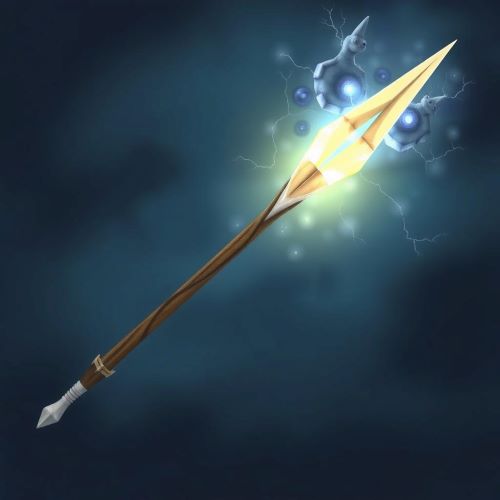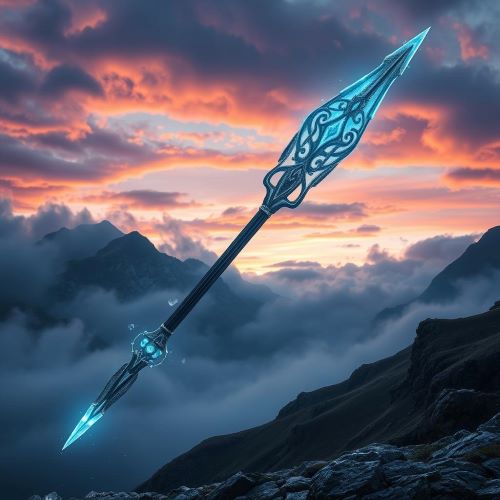Gungnir : The Unerring Spear of Odin
Gungnir
Introduction
In the vast pantheon of Norse mythology, few artifacts command the reverence and mystique of Gungnir, the divine spear of Odin, the Allfather. Meaning “the swaying one” in Old Norse, Gungnir represents precision, authority, and the inescapable hand of fate. It is more than a mere weapon—it is an extension of Odin’s will and wisdom, symbolizing his dominion over war, justice, and destiny itself. The spear never misses its target, no matter who wields it, making it a potent emblem of inevitability in the Norse worldview.
Origins
The origins of Gungnir trace back to the cunning of Loki and the craftsmanship of the Sons of Ivaldi, legendary dwarven smiths famed for creating some of the most powerful artifacts in Norse mythology. After Loki mischievously cut off Sif’s golden hair, he sought to make amends by commissioning the dwarves to forge extraordinary gifts for the gods. Among these creations were Sif’s restored golden hair, the ship Skidbladnir, and Gungnir, a spear unlike any other.
Forged from a rare divine metal found only in Svartalfheim, Gungnir was perfectly balanced and engraved with sacred runes that infused it with unerring accuracy and magical potency. These runes were said to grant the spear not only flawless precision but also the power to bind oaths and influence fate. In the ancient Prose Edda, Snorri Sturluson emphasizes the weapon’s perfection, describing it as one that could pierce any material and never deviate from its path. Through this creation, the dwarves cemented their reputation as the master forgers of divine relics.
Think you know your myths and legends? Dive into the world of ancient stories and test your knowledge with our engaging quizzes on Mythlok!
Powers
The powers of Gungnir go far beyond its physical attributes. The spear’s defining ability is its unerring accuracy—once thrown, it never misses its mark. The runes carved along its shaft amplify its divine essence, granting it mystical properties associated with Odin’s mastery of magic and fate. These runes are not merely decorative; they embody the secret language of the cosmos, connecting the spear to the forces that govern life and destiny.
In battle, Gungnir is said to cause enemies to tremble before it even strikes, its presence alone inspiring awe and fear. It can pierce any armor or barrier, both physical and spiritual, reflecting Odin’s unchallengeable will. The spear also served a ritual purpose—Odin used it to consecrate oaths and sacrifices, symbolizing the gods’ eternal bond with the mortal world. In many accounts, the throwing of a spear over an enemy army before combat became a sacred act invoking Odin’s blessing and ensuring divine favor in war.
Owners/Users
Gungnir belongs solely to Odin, who is both its master and spiritual counterpart. The weapon is depicted in numerous Norse poems, sagas, and carvings, always as part of Odin’s regal and formidable image. Often described as “Gungnis váfaðr,” meaning “Gungnir’s shaker,” Odin wields the spear as both a symbol of power and a manifestation of his wisdom and sacrifice.
No other god or mortal is known to have wielded Gungnir. This exclusivity highlights its sacred status—it is not just a weapon but a divine tool of cosmic governance. Through Gungnir, Odin’s role as ruler, warrior, and seeker of knowledge is unified. Even when he sacrificed himself upon Yggdrasil, the World Tree, to gain the wisdom of the runes, he pierced his own body with Gungnir. This act of self-inflicted pain became a ritual of transcendence, linking the spear forever to enlightenment and sacrifice.
Instances used
Gungnir features prominently in several critical moments within Norse mythology, marking events that shape the fate of gods and men alike.
In the Æsir-Vanir War, Odin hurled Gungnir over the ranks of the Vanir gods, declaring the onset of battle. This act not only initiated the divine conflict but also set a precedent for warriors across the Viking world, who would replicate the gesture before battle to seek Odin’s blessing and invoke victory. The spear thus became a divine instrument of both war and fate.
Another defining moment occurs during Odin’s self-sacrifice. In his relentless pursuit of wisdom, Odin hung himself from Yggdrasil for nine nights, wounded by Gungnir. Through this ordeal, he gained the knowledge of the runes, the sacred symbols that form the foundation of magic and cosmic order. Gungnir, in this context, becomes a conduit of transformation—representing pain, sacrifice, and ultimate enlightenment.
The spear’s final and most dramatic appearance is at Ragnarök, the foretold end of the world. Odin rides into battle atop his steed Sleipnir, holding Gungnir high as he leads the Einherjar, the fallen warriors of Valhalla, into their final stand against the forces of chaos. Despite his valor, Odin meets his fate at the jaws of Fenrir, the monstrous wolf. Yet even in defeat, Gungnir remains a symbol of courage, prophecy, and renewal—its fall marking not the end, but the eternal cycle of destruction and rebirth that defines Norse cosmology.
Source
Odin’s Glory. (2025). Gungnir vs. Mjölnir: Which Was the Most Powerful Norse Weapon? Retrieved from https://odins-glory.com/blogs/blog/gungnir-vs-mjolnir-which-was-the-most-powerful-norse-weapon
NorseMythologist. (2022). Gungnir: Odin’s Mighty Spear. Retrieved from https://norsemythologist.com/gungnir/
Ragnar Armoury. (2023). Gungnir: Odin’s Mighty Spear and Symbol of Divine Power. Retrieved from https://ragnararmoury.com/blogs/viking-symbols/gungnir-odin-s-mighty-spear-and-symbol-of-divine-power
Wikipedia contributors. (2023). Gungnir. Wikipedia. https://en.wikipedia.org/wiki/Gungnir
Larrington, C. (2014). The Poetic Edda. Oxford University Press.
Hollander, L. M. (2007). The Prose Edda. Penguin Classics.
Simek, R. (2007). Dictionary of Northern Mythology. Boydell & Brewer.
Davidson, H. R. E. (1993). Gods and Myths of Northern Europe. Penguin Books.
Frequently Asked Questions
What is Gungnir in Norse mythology?
Gungnir is the legendary spear of Odin, the Allfather in Norse mythology. Forged by the dwarves known as the Sons of Ivaldi, it is said to never miss its mark and serves as a powerful symbol of divine authority, war, and destiny.
Who created Gungnir and how was it made?
Gungnir was crafted by the Sons of Ivaldi, master dwarven blacksmiths renowned for making other divine artifacts like Thor’s hammer, Mjölnir. The spear was forged from a rare, divine metal and engraved with sacred runes that gave it magical accuracy and power.
What are the magical powers of Gungnir?
Gungnir’s main power is its perfect precision—it always hits its intended target. The runes inscribed along its shaft also grant it mystical properties, connecting it to Odin’s mastery over magic, fate, and oaths. It can pierce any barrier, both physical and spiritual.
What does Gungnir symbolize today?
In modern culture, Gungnir symbolizes divine precision, authority, and destiny. It continues to appear in art, literature, and media as a representation of Odin’s wisdom and power, reminding audiences of the Norse belief in fate and the inevitability of destiny.
How did Odin use Gungnir in mythology?
Odin used Gungnir in many significant events, including initiating the Æsir–Vanir War by casting it over his enemies, sacrificing himself upon Yggdrasil while wounded by it to gain wisdom, and wielding it during Ragnarök in his final battle against Fenrir.








